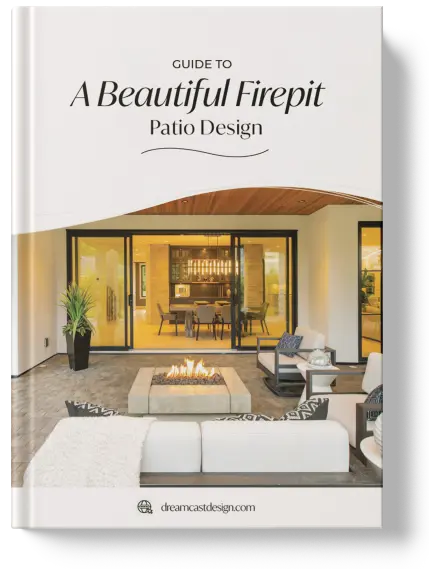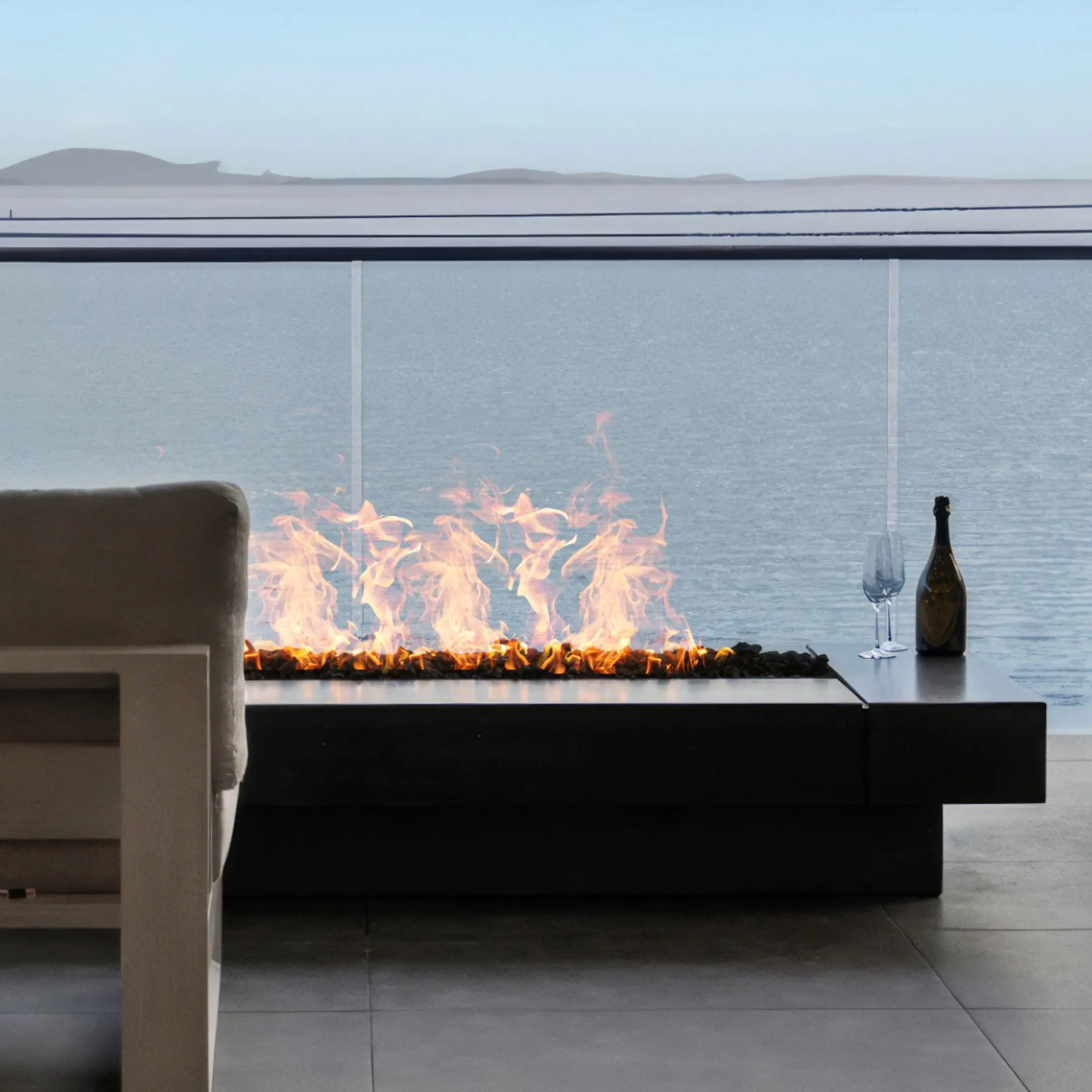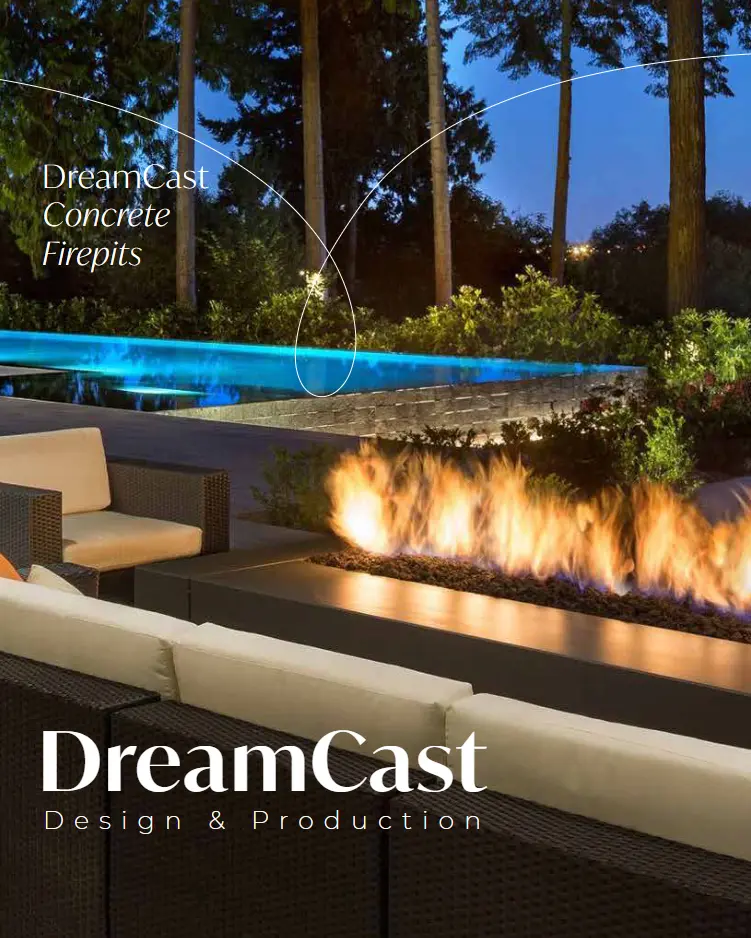The best fuel for your fire pit: Natural Gas, Propane or Wood?
A concrete fire pit is a stunning addition to any outdoor space, offering a cozy gathering spot and an inviting atmosphere for family and friends. When choosing a fire pit for your home, one important factor to consider is the fuel you’ll use. The three most popular fuel options for fire pits are wood, propane, and natural gas. Each has its own advantages and disadvantages, and the best choice depends on your needs, lifestyle, and preferences.
Let’s dive into the pros and cons of each option to help you make the right decision.
1
Natural Gas Fire Pits
Natural gas fire pits are similar to propane models, but instead of using a tank, they connect directly to your home’s natural gas line. This means you’ll have an unlimited fuel supply, provided you have a gas line installed. You can opt to run this gas line to a fire feature, or if you wish to keep more flexibility in future placement then you can install a Quick Connect box and run a flexible hose to the fire feature that will allow easy connection and disconnection.
Pros of Natural Gas
- Continuous Fuel Supply: Once you’ve hooked up your fire pit to your home’s natural gas line, you’ll have an endless supply of fuel without worrying about refilling tanks.
- Cost-Effective: While the initial cost of installing a gas line can be high, natural gas is typically cheaper than propane in the long run, which can help save money over time.
- Clean and Efficient: Like propane, natural gas burns cleanly with minimal smoke or odor. If you’re looking for a low-maintenance option, natural gas is a great choice.
- No Tank Refills: You don’t have to worry about swapping out propane tanks or keeping extras on hand, making natural gas a more convenient option for long-term use.
- Seamless Landscape: Hard plumbed gas lines are usually laid under pavers or decking and connect directly to your fire pit from below making for a very visually uncluttered view.
Cons of Natural Gas
- Installation Costs: The major drawback of natural gas is the upfront cost of installation. If you don’t already have a gas line running to your backyard, you’ll need to pay for the infrastructure, which can be expensive.
- Limited Mobility: Unless you’ve installed your firepit with a hose to a quick connect box you’re limited in terms of placement. You can’t easily move the fire pit around, unlike a propane model that’s portable.
2
Propane Fire Pits
Propane fire pits are one of the most popular choices for those who want an easy-to-use and low-maintenance option. A propane fire pit uses a portable propane tank, which is typically stored underneath the fire pit or in a hidden compartment. Propane is actually refined natural gas. It burns cleaner and hotter than natural gas, so it is considered a much more efficient gas fuel. Propane is also much more available than natural gas because after it is liquified, it’s easy to store in tanks and transport. For example, propane can be delivered by truck to a remote home that doesn’t have natural gas lines available.
Pros of Propane
- Convenience: Propane fire pits are incredibly convenient. With a simple twist of a knob or push of a button, you can have an instant flame, making it easy to enjoy a fire without any hassle.
- Clean Burn: Propane burns cleanly, producing very little smoke or ash. This is especially beneficial if you want to keep your outdoor space clean and avoid the irritation that smoke can cause, particularly in windy conditions.
- Adjustable Flame: Many propane fire pits come with adjustable flame controls, allowing you to easily modify the intensity of the fire based on your preference.
- No Mess: With propane, there is no need to deal with wood or ashes. After your fire burns out, you simply shut off the valve, and there’s no cleanup required.
- Simpler Install: If you are using a portable propane tank then you do not need to worry about the cost or logisitics of running a hard-plumbed gas line to your fire pit location.

Cons of Propane
- Limited Burn Time: The burn time for propane is dependent on the size of your tank and the out put of your burner. Larger tanks will give you more burn time, but you may need to refill or replace the tank more frequently than you’d like.
- Cost: While the initial investment in a propane fire pit may not be too high, the ongoing cost of refilling propane tanks can add up over time.
- Hide the Propane Tank or Hose: It will be necessary to hide the propane tank and a hose. This is often acheived through a rug, and/or a propane tank cover. In the fire pit models that house a propane tank inside you will have to deal with either taller fire pits to accommodate the height of the tank, or a less powerful firepit to run on a small sideways tank.
Pro tip
How long does a propane tank last?
You will get about 95 hours per gallon if burned at a rate of 1000 BTU per hour. As an example if you have a heater with a BTU rating of 30,000, then a gallon of propane will last you 3.17 hrs.
GET IN TOUCH
Still have questions about fire pit fuel?
We are happy to help you choose the best option!
3
Wood-Burning Fire Pits
Wood-burning fire pits are the traditional choice for outdoor fires, and they create a classic, rustic atmosphere. These fire pits burn real wood logs and produce that signature crackle and smell that many people associate with a perfect fire.

Pros of Wood
- Classic Experience: If you love the smell of burning wood, the crackle of a fire, and the warmth it produces, a wood-burning fire pit is the best choice for classic fire pit experience.
- Availability of Fuel: Wood is relatively easy to obtain, especially if you live near forests or have a local supplier. If you have access to free firewood, it can be the most cost-effective option.
- More Heat: Wood burns hotter than propane or natural gas, but you will need to keep adding fuel to maintain a robust flame.

Cons of Wood
- Maintenance and Cleanup: Wood-burning fire pits require regular cleaning. Ashes need to be removed, and the pit may need to be maintained to ensure safe burning. This can be a hassle for those who prefer a low-maintenance option.
- Smoke and Odor: The smoke from a wood fire can be irritating, particularly in windy conditions. Additionally, the smell of wood smoke can linger on clothing and furniture, which some people may find unpleasant.
- Urban Restrictions: Many urban municipalities regulate wood burning appliances and limit their use during fire season. Some areas restrict their use entirely. So, check your local bylaws if a wood burning fire pit allowed in your city.
- Fire Safety: Wood fires require a bit more attention to safety. It’s important to follow proper fire safety guidelines and be cautious of embers or sparks that could cause a fire hazard.
Conclusion
Which Fuel is Right for You?
Ultimately, the best fuel for your concrete fire pit comes down to your preferences and how you plan to use your fire pit. Here’s a quick breakdown:
- Choose wood if you crave the authentic, traditional experience of a real fire, and don’t mind extra maintenance and cleanup. It’s great for those who love the ambiance and charm of a wood-burning fire.
- Go with propane if you want convenience, a clean burn, and the flexibility to move the fire pit around. It’s ideal for those who prioritize ease of use.
- Opt for natural gas if you’re looking for a long-term, low-cost solution and don’t mind a higher initial investment for installation. It’s perfect for those who want a consistent fuel supply and don’t want to deal with tanks.
No matter which option you choose, your concrete fire pit will undoubtedly enhance your outdoor space and provide you with years of enjoyment.

DISCOVER HOW TO CREATE YOUR PERFECT PATIO
Download this inspirational guide complete with tips & layouts to transform your patio today.

Inspiration
Looking for more ideas?
Check out our product gallery for more inspiration, or follow us on Instagram to keep up with the latest trends and promotions.
Author
Catherine Traschenko
Fire Products Design Specialist
As a partner at DreamCast, she has been immersed in the decorative concrete industry since 2007, specializing in fire pits & mantels. With a passion for interior design her expertise drives innovative design and exceptional craftsmanship.





